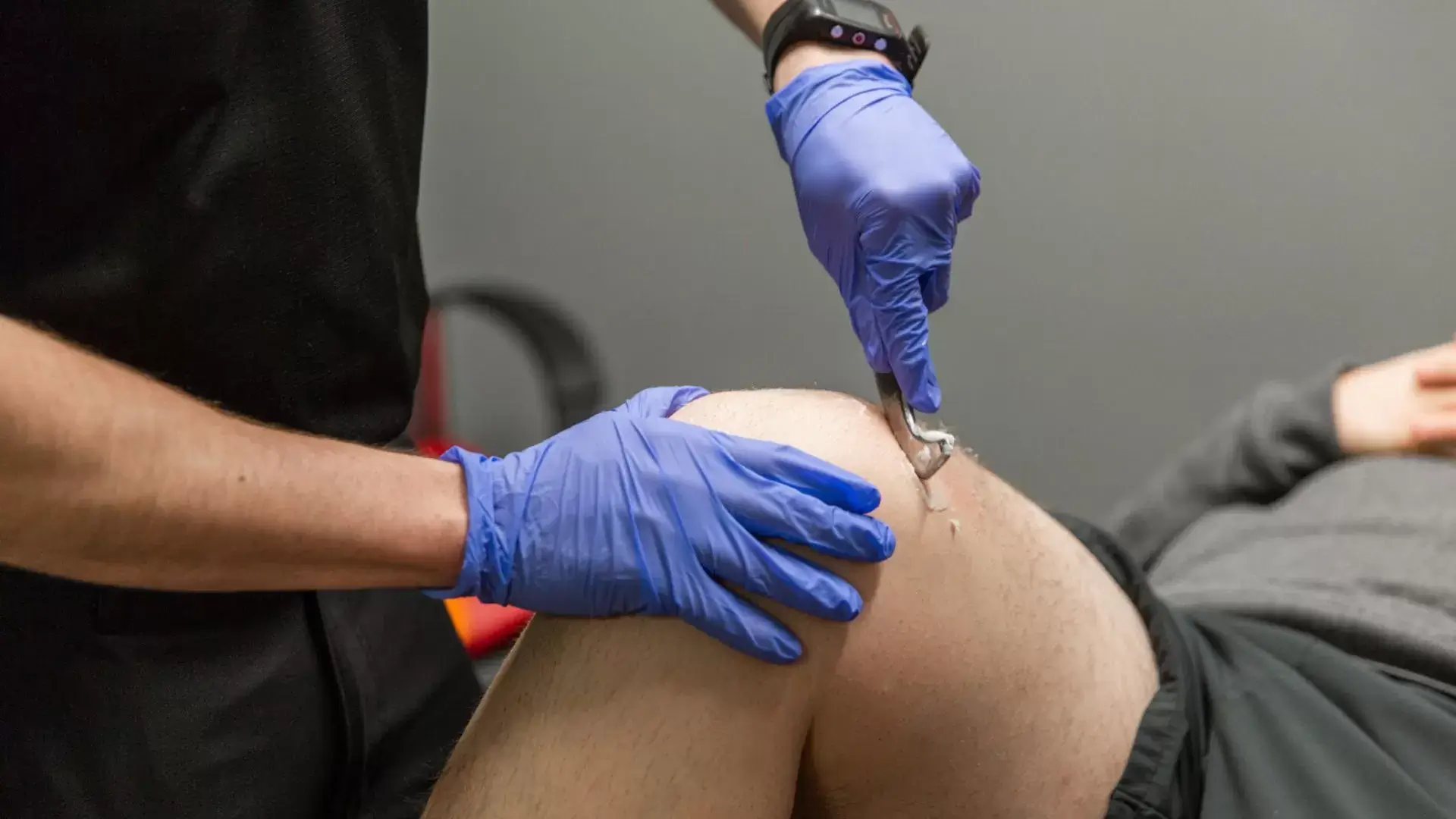When it comes to addressing a meniscus tear, we recognize the importance of exploring all available options, including Chiropractor for Meniscus Tear and chiropractic care in Mississauga. This approach not only focuses on alleviating pain but also aims to enhance mobility and promote overall knee health. By utilizing tailored treatment plans, skilled chiropractors can help us regain strength and stability, paving the way for a smoother recovery. Yet, understanding the full spectrum of chiropractic benefits and how they can specifically support our healing journey remains essential. So, what steps can we take to guarantee peak recovery and prevent future injuries?

At Mississauga Physio Chiro Clinic, we specialize in providing extensive physiotherapy and chiropractic services tailored to effectively address meniscus tears and enhance your overall recovery. We recognize that a meniscus tear can lead to significant knee pain and limit your daily activities. That’s why we focus on individualized treatment plans that prioritize your specific needs and goals.
Our Expert Physiotherapy and Chiropractic Services in Mississauga are designed to promote ideal knee rehabilitation through a combination of targeted exercises, manual therapy, and advanced modalities. By employing non-surgical meniscus treatment techniques, we aim to alleviate pain, restore function, and enhance mobility. We work closely with you to educate and empower you throughout the recovery process, ensuring that you feel supported every step of the way.
In addition to addressing knee pain associated with meniscus tears, our multidisciplinary approach also considers your overall health and well-being. We believe that a collaborative effort between our team and you is essential for achieving the best possible outcomes. Together, we’ll navigate your recovery journey, guiding you towards a return to your active lifestyle with confidence and strength. Your recovery is our priority, and we’re here to help you every step of the way.
Meniscus tears often occur due to a combination of acute injuries and degenerative changes, making it essential to understand their causes and associated risk factors. A meniscal injury can happen suddenly, often during activities that involve twisting or heavy lifting, which places undue stress on the knee cartilage. Sports like basketball, soccer, and skiing are common culprits for such knee injuries.
However, it’s not just acute incidents that we need to take into account. Over time, wear and tear can lead to a cartilage tear, especially in individuals over 40. As we age, our knee cartilage becomes less resilient, increasing the risk of injury even with minor movements. Other risk factors include obesity, which adds extra weight to the joints, and previous knee injuries that can compromise stability.
Understanding these causes helps us in knee pain management. By recognizing the potential for meniscus tears, we can take proactive measures to strengthen the knee and maintain proper alignment through chiropractic care and rehabilitation. By addressing these risk factors, we can work towards preventing further knee injuries and enhancing our overall joint health.
Recognizing the symptoms of a meniscus tear is vital for timely intervention and effective treatment, as early detection can markedly enhance recovery outcomes. When we experience a meniscus tear, the first signs often include joint pain, which may manifest during physical activity or after prolonged periods of rest. Alongside this, we might notice knee swelling, which can occur soon after the injury, leading to discomfort and stiffness.
Knee instability is another significant symptom; we may feel as if our knee is giving way or unable to support our weight. This sensation can be alarming and often prompts us to seek medical attention. Additionally, we should be aware of a reduced range of motion, as bending or straightening our knee may become increasingly difficult.
If we find ourselves experiencing these symptoms, it’s vital to consult a healthcare professional. By recognizing these early indicators of a meniscus tear, we can take proactive steps toward recovery, ensuring that we receive the appropriate care and support to restore our knee’s function and alleviate pain.
Chiropractic care offers several benefits for recovering from a meniscus tear, focusing on pain relief, improved mobility, and enhanced overall knee function. By incorporating targeted treatments and techniques, we can support the healing process after a meniscus repair, helping to reduce chronic knee pain effectively.
Our approach often includes physiotherapy for meniscus tear recovery, which emphasizes restoring strength and flexibility. We guide patients through knee mobility exercises designed to improve range of motion, allowing for smoother and more comfortable movement. Additionally, knee stability training plays a vital role in preventing re-injury and ensuring long-term joint health.
We understand that each patient’s needs are unique, and our tailored chiropractic care plans are developed with individual recovery goals in mind. By addressing not just the symptoms but also the underlying issues contributing to knee discomfort, we promote a thorough healing experience.
Through consistent chiropractic care, we aim to enhance the overall function of the knee, empowering patients to return to their daily activities without pain. If you’re dealing with a meniscus tear, we’re here to support you every step of the way on your journey to recovery.

Accurate diagnosis and thorough post-injury evaluation are essential steps in effectively managing a meniscus tear and ensuring ideal recovery. When we experience a knee injury, it’s critical to pinpoint the exact nature of the damage. A healthcare professional will typically conduct a physical examination, followed by diagnostic imaging, such as an MRI, to confirm the presence and severity of a meniscus tear.
Once diagnosed, we can explore various treatment options. Initially, we may start with conservative management, which often includes rest, ice, compression, and elevation (RICE). If symptoms persist, physical therapy for meniscus tear becomes essential. A tailored rehabilitation program helps strengthen the surrounding muscles, restore range of motion, and improve overall knee function.
For those undergoing surgery, post-surgical knee rehab is equally significant. This phase focuses on gradual recovery, ensuring we regain strength and stability in the knee joint. By diligently following our rehabilitation plan, we can optimize our recovery and return to our daily activities with confidence. Remember, our journey toward healing is supported by a thorough evaluation and targeted interventions, guiding us every step of the way.
When dealing with knee pain, seeking adjustments from a chiropractor can enhance joint alignment and alleviate discomfort effectively. Chiropractic adjustments are designed to address misalignments in the knee joint, which can be a significant factor in conditions like knee osteoarthritis and injuries such as meniscus tears. By focusing on proper joint alignment, we can help reduce pain and improve mobility.
During our sessions, we’ll assess the knee’s biomechanics to identify any misalignments that may be contributing to your discomfort. Through targeted chiropractic adjustments, we can realign the joint, relieving pressure on surrounding tissues and promoting faster healing. This can be especially beneficial during meniscus tear recovery time, as proper alignment can support the healing process and potentially shorten recovery duration.
Moreover, consistent chiropractic care can help prevent future injuries by ensuring that the knee remains in ideal alignment. As we work together, we’ll create a personalized plan that addresses your specific needs, ultimately leading to enhanced function and reduced pain. Remember, taking proactive steps toward joint health can make a significant difference in your overall well-being.
Soft tissue therapies, such as myofascial release and massage, can play an essential role in facilitating knee recovery by alleviating tension and promoting circulation in the affected areas. These techniques are particularly beneficial for individuals recovering from a meniscus tear, as they help to reduce knee pain and improve overall mobility.
Myofascial release focuses on relieving tightness in the fascia, which can contribute to discomfort and restricted movement. By applying gentle, sustained pressure, we can help release tension and restore normal function to the knee joint. This therapy not only addresses physical symptoms but also enhances our overall sense of well-being during the recovery process.
Massage therapy complements myofascial release by further promoting relaxation and increasing blood flow to the injured area. By targeting specific muscle groups around the knee, massage can alleviate pain and stiffness, making it easier for us to engage in rehabilitation exercises as we progress in our recovery.
Incorporating these soft tissue therapies into our treatment plan can greatly expedite knee recovery, providing relief from pain while fostering an environment conducive to healing and rehabilitation. Together, we can create a thorough approach to overcoming the challenges posed by a meniscus tear.
To enhance knee stability after a meniscus tear, it’s essential for us to focus on strengthening the supporting muscles and ligaments surrounding the joint. By engaging in targeted meniscus strengthening exercises, we can effectively reduce knee joint instability and promote better overall function.
Quadriceps strengthening is vital, as these muscles play a key role in stabilizing the knee during movement. Exercises like squats and leg presses can help build the necessary strength. Similarly, we shouldn’t overlook hamstring strengthening, which is equally important for maintaining balance around the knee. Incorporating activities such as hamstring curls or bridges will support our rehabilitation journey.
Additionally, we may consider using a knee brace during our recovery. A brace can provide extra stability, allowing us to perform these exercises with greater confidence and safety. As we work towards enhancing our knee stability, it’s important to progress gradually, listening to our bodies and adjusting as needed.

Exploring non-surgical treatment options for meniscus tear relief can provide us with effective pathways to manage pain and improve function without the need for invasive procedures. First, we can consider anti-inflammatory treatments, such as non-steroidal medications, which help reduce swelling and discomfort. These options can be easily integrated into our daily routine and provide immediate relief.
Additionally, utilizing knee support braces can stabilize the joint, allowing us to engage in activities while minimizing stress on the injured meniscus. Physical therapy often complements these approaches, focusing on gentle exercises to enhance mobility and strengthen surrounding muscles.
Regenerative medicine techniques, such as platelet-rich plasma (PRP) therapy, are also gaining traction. This innovative approach harnesses our body’s healing properties to promote recovery and potentially restore the damaged tissue.
Incorporating knee rehabilitation and mobility work into our recovery plan can considerably enhance healing and restore function after a meniscus tear. This approach not only addresses joint stiffness but also focuses on optimizing knee biomechanics, which is essential for a successful recovery.
Through targeted mobility work, we can improve our range of motion, making daily activities more manageable and reducing the risk of future injuries. Engaging in specific stretches and exercises helps keep the knee joint flexible and strengthens the surrounding muscles, which can play a key role in meniscus tear prevention.
Moreover, our rehabilitation program should include supervised sessions to guarantee we’re performing movements correctly and effectively. Working with a chiropractor or physical therapist allows us to receive personalized guidance, ensuring we’re engaging in the right mobility work tailored to our specific needs.
As we progress, we’ll likely notice improvements not just in pain relief but also in our overall knee function. By committing to a consistent knee rehabilitation plan, we can enhance our recovery journey and regain confidence in our knee’s capabilities. Let’s take these important steps together for a more successful outcome.
Building knee strength and stability is vital for anyone recovering from a meniscus tear, as it not only enhances our overall joint function but also greatly lowers the risk of future injuries. By focusing on targeted training, we can effectively rebuild the muscles surrounding the knee, which is essential for joint preservation.
Incorporating specific exercises that emphasize knee strength and stability is key. These may include squats, lunges, and balance training, which help to strengthen the quadriceps, hamstrings, and calf muscles. This targeted training not only improves our ability to support the knee joint but also reduces the likelihood of re-injury from sports activities.
Moreover, we should pay attention to our form and technique during these exercises. Proper alignment guarantees that we’re not putting unnecessary stress on the knee, which can lead to further complications. It’s beneficial to work with a professional who can guide us in creating a personalized training program tailored to our needs.
Ultimately, by committing to building our knee strength and stability, we’re taking proactive steps towards a healthier knee and a more active lifestyle, minimizing the risks associated with past sports injuries.
Gait analysis plays an indispensable role in identifying biomechanical issues that may contribute to knee problems, allowing us to make necessary corrections for improved knee health. By examining our walking and running patterns, we can pinpoint deviations that may lead to improper knee alignment and increase the risk of knee ligament injuries or running injuries.
Through this analysis, we can discover how factors like foot positioning, hip movement, and overall posture affect our biomechanics. Once we identify these issues, we can implement targeted biomechanical corrections. These may include specific exercises to strengthen muscles that support proper knee alignment and adjustments to our movement patterns to reduce strain on the knees.
Moreover, addressing these biomechanical deficiencies not only helps in recovering from existing injuries but also plays a significant role in preventing future issues. By taking a proactive approach to our knee health through gait analysis, we empower ourselves to maintain ideal function and reduce the risk of further injuries. Ultimately, understanding our biomechanics is essential for achieving longevity in our physical activities and ensuring our knees remain healthy and strong.
Kinesiology taping and knee braces can provide vital support for those recovering from a meniscus tear, helping to stabilize the knee and alleviate discomfort during the healing process. By utilizing knee taping, we can enhance proprioception and reduce strain on the injured area, allowing for improved mobility and function. Kinesiology taping also helps to promote circulation, which may expedite recovery.
In our practice, we often recommend knee braces as an additional layer of support. These braces can limit excessive movement and protect the knee from further injury, particularly during activities that might stress the joint. Orthopedics specialists frequently emphasize the importance of combining these supportive measures with an extensive rehabilitation program to guarantee ideal recovery.
It’s vital that we select the appropriate type of kinesiology taping or knee brace tailored to each individual’s needs. This personalized approach can greatly impact the effectiveness of our recovery strategy. By working together, we can create a supportive environment that fosters healing and helps us return to our daily activities with confidence. Remember, effective recovery from a meniscus tear involves a holistic approach, and the right support is vital.
Proper nutrition plays an essential role in supporting knee healing and reducing inflammation after a meniscus tear. By focusing on anti-inflammatory strategies, we can help accelerate recovery and improve overall joint function. Incorporating foods rich in omega-3 fatty acids, such as fatty fish, flaxseeds, and walnuts, can greatly reduce inflammation. Additionally, we should prioritize fruits and vegetables high in antioxidants, like berries and leafy greens, to combat oxidative stress.
It’s also important to stay hydrated, as proper hydration supports joint lubrication and overall health. We may want to limit processed foods and sugars, which can exacerbate inflammation. In some cases, individuals might consider consulting with a sports medicine professional for tailored advice.
While cortisone injections for knee pain can provide temporary relief, they shouldn’t be the sole focus of our treatment strategy. Instead, combining these injections with a strong nutritional plan can enhance our healing process. By embracing these anti-inflammatory strategies, we’ll not only support our knee healing but also contribute to our long-term well-being. Together, we can take proactive steps towards recovery and improved knee health.
Maintaining correct knee alignment is essential for preventing meniscus tears, as improper mechanics can increase the risk of injury during physical activities. We should focus on injury prevention strategies that promote proper knee alignment to minimize meniscus strain and reduce the likelihood of cartilage damage.
Engaging in exercises that strengthen the muscles around the knee can provide support and stability. For instance, incorporating quadriceps and hamstring strengthening routines can help us maintain proper alignment during weight-bearing activities. Additionally, practicing proper techniques during sports or exercise, such as keeping our knees aligned with our toes, can greatly reduce the risk of injury.
It’s also important to listen to our bodies. If we experience any weight-bearing pain, we should seek guidance to address the underlying issues before they lead to more severe injuries, like a meniscus tear. Regular chiropractic check-ups can help us assess our knee alignment and identify any areas of concern.
Booking a chiropractic consultation is a proactive step we can take to effectively address and manage a meniscus tear. During our initial visit, we’ll discuss our symptoms and any previous treatments, such as NSAIDs for knee pain, that we’ve tried. This helps our chiropractor understand our specific situation and tailor a treatment plan to our needs.
Chiropractic care can play a crucial role in reducing pain and improving function, especially when considering options like PRP therapy for meniscus tear or stem cell therapy for meniscus tear. These innovative treatments can promote healing and may help us avoid invasive procedures like knee arthroscopy.
Our chiropractor will evaluate our knee’s biomechanics and recommend exercises to strengthen the surrounding muscles, which is essential in addressing meniscal degeneration. By focusing on rehabilitation and recovery, we can regain mobility and reduce the risk of further injury.
Ultimately, scheduling a chiropractic consultation offers us a thorough approach to managing a meniscus tear, enabling us to explore various non-surgical treatment options tailored to our unique situation. Together, we can work towards a healthier, pain-free future. Contact us now!
Located in the Regional Municipality of Peel, the City of Mississauga is known for its vibrant community, diverse cultural offerings, and robust economic landscape. As residents of this thriving city, we benefit from its accessibility to healthcare options, including specialized treatments for conditions like a meniscus root tear.
In Mississauga, we have numerous healthcare providers, from general practitioners to chiropractic specialists, who can assist with acute knee injuries. These professionals often recommend rice therapy—Rest, Ice, Compression, and Elevation—as an initial approach to managing pain and swelling before considering more invasive options like knee surgery.
Moreover, our city prides itself on its commitment to health and wellness, making it easier for us to find support when dealing with musculoskeletal issues. The integration of chiropractic care into our local healthcare system provides us with alternative treatment options that can complement traditional methods.
With the right resources at our disposal, we can effectively address knee-related injuries and improve our quality of life. In Mississauga, we’re not just a community; we’re a network of support dedicated to maintaining our health and well-being.

When we consider recovery from a meniscus tear, it typically varies based on the severity of the injury and our overall health. Generally, we can expect a timeframe of six weeks to three months for healing, depending on factors like age and activity level. It’s important to follow a proper rehabilitation plan, as this can greatly expedite our recovery and help us regain strength and mobility effectively. Patience and consistency are key!
When considering chiropractic treatment for knee injuries, we should be aware of potential risks. While many people benefit from chiropractic care, there’s a chance of experiencing discomfort, worsened symptoms, or even injury if the treatment isn’t tailored to our specific condition. It’s essential to work with a qualified chiropractor who understands our medical history. Open communication about our symptoms can help minimize risks and guarantee a safer, more effective treatment plan.
When dealing with a meniscus tear, we should approach exercise cautiously. While staying active can be beneficial, it’s vital to avoid high-impact activities that may exacerbate the injury. Low-impact exercises, like swimming or cycling, can help maintain our fitness without putting undue stress on the knee. It’s best to consult with a healthcare professional to tailor an exercise plan that guarantees we’re supporting our recovery while staying active.
During our first chiropractic appointment, we can expect a thorough assessment. The chiropractor will review our medical history and conduct a physical examination to understand our specific concerns. They’ll likely discuss their findings and develop a personalized treatment plan tailored to our needs. We might also receive some initial adjustments or therapies to alleviate discomfort. Overall, it’s an opportunity for us to ask questions and feel empowered about our health journey.
When we’re considering whether our insurance will cover chiropractic treatment for a meniscus tear, it’s crucial to check our specific policy details. Many plans do offer coverage for chiropractic care, but there can be limitations or requirements like referrals. We should contact our insurance provider directly to understand what’s included and any necessary documentation we may need. This way, we can make informed decisions about our treatment options and financial responsibilities.
Reach out to us today to book an appointment or learn more about our services. Our friendly team is here to answer your questions and help you take the first step toward improved health and wellness.
(647) 372-1209

At our “Mississauga Physio Chiro Clinic”, we are dedicated to providing personalized care that addresses the root cause of your discomfort. With a team of experienced physiotherapists and chiropractors, we focus on restoring your mobility, relieving pain, and enhancing your overall well-being.